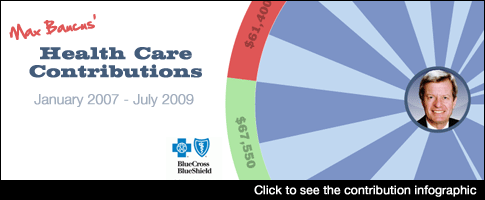Tracking Lobbyists’ Real Influence
We’ve got some new data to munch on today that we’re excited about. Essentially, this new data helps show us that when lobbyists from a special interest – in this first case, the health care industry – meet with our representatives, many lobbyists represent much more than just the contributions attributed to them if we were to look them up.
It’s important we know lobbyists’ REAL influence on the people we elect to represent us – and before today, that’s not something we could really do.
The deal is that decision makers (i.e. senators) in the health care debate are not only receiving big bucks from members of the health and insurance industries – but also from the numerous individual lobbyists that represent the industries. All of that money “clustered” or “bundled” together is much more influential than any contribution by itself. So, when one of the lobbyists in a cluster walks into a meeting with a representative, it stands to reason that representative listens to them …how do we say… with a more fully tuned ear.
As citizens holding government accountable, another way to think about this new information is that while yesterday you may have looked up a lobbyist online and seen only that the individual had contributed a couple hundred dollars to a senator, you can now see the entire ‘bundle’ of contributions around that lobbyist or company which can total in the tens of thousands. MUCH more ‘influence’ than what was previously reflected.
Larry Makinson, one of Sunlight’s senior fellows that led our investigation probably said it best: “When we saw a dozen, two dozen, even three dozen lobbyists for a single company giving to the same members as their clients, we were frankly stunned.”
And we should be.
We should know who is exerting the most influence on the men and women we elect (and pay) to represent us, and we should know what that influence is about so we can make sure our voice is heard as well – but so far, we haven’t been able to see that influence represented with real data.
While we have been able to go online and track some of how special interests have contributed to our representatives thanks to OpenSecrets.org – what we’ve had access to is only part of the story.
Through our month-long investigation in partnership with OpenSecrets.org, our investigators uncovered never-before-seen webs of campaign contributions from outside lobbyists and their clients to key members of Congress involved in the health care debate.
Again, visibly suggesting that special interest giving is strongly enhanced by the K Street contributors they hire – and of course showing just how much influence these groups have.
Standing out, as usual, in our first examination is Sen. Max Baucus, chairman of the powerful Senate Finance Committee, and author of the main health care reform bill now being debated in the Senate. He is, not surprisingly, one of the biggest beneficiaries of this one-two punch from the lobbyists and their clients. From January 2007 through June 2009, Baucus collected contributions from 37 outside lobbyists representing PhRMA, the pharmaceutical industry’s chief trade association, and 36 lobbyists who listed drug maker Amgen Inc. as their client.
In all, 11 major health and insurance firms had their contributions to Baucus boosted through extra donations from 10 or more of their outside lobbyists. When you click on this visualization, you can see that the combined contributions of a group like Amgen is much larger than the company contribution alone.
You can see our full list here. In total – which you can see broken down in our animation above – Max Baucus has received more than $453,000 from the health care industry – or 20% of his cash on hand. How would that affect your decision if you were debating an issue?
In many ways it boils down to this: information regarding who is meeting with whom, who is receiving money from whom – who is having influence on whom – on Capitol Hill should be public information.
To us, “public” means that information is placed online in as close to real time as possible – allowing all of us to hold our elected officials accountable. We’re not there yet – or really even close – but we’re working on it, and this health care data is just the first in a series we’ll be releasing around this new way of looking at special interests and their ‘real’ influence.
Stay tuned and thank you for helping us shine the light!


